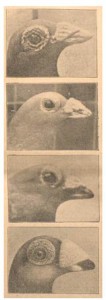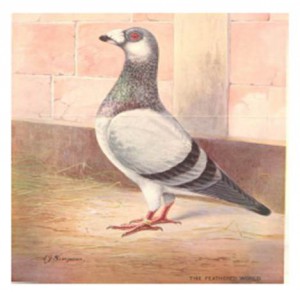
January 30, 2015, by Matt
Pigeon chat
I’m beginning to get a reputation. “I’ve seen something about pigeons recently” is how most people greet me these days, and I can barely come across anyone anymore without them talking to me about my feathered research subject. Who’d have thought pigeons would provide such a talking point?
But, then again, it has long been the case that pigeons have caused a flap. As I sit in the British Library wading through issues of The Feathered World and The Racing Pigeon from the early twentieth century, I realise that these magazines were, in fact, tools for communication between pigeon fanciers. Renowned fanciers wrote regular columns for the magazines (the title of this blog is actually taken from a column written in The Feathered World under the pseudonym ‘The Stray’), advising the Fancy and inviting their responses. The letters pages are bursting with dialogue and debate about how best to breed, care for, and prepare pigeons for shows or races, some letters causing enough debate for the editor to add “much correspondence unavoidably crowded out”.
Let me give you an example from The Feathered World – a magazine established in 1889 and devoted to fancy pigeons and poultry. On January 16th 1914, a well-known fancier called Mr Fletcher sent in four pictures (below) of the Dragoon, at the time a very popular breed of fancy pigeon bred for exhibition. The pictures were accompanied by a short caption: “Beak setting in Dragoons: At top correct beak setting is exemplified in one of Mr. Moore’s yellows, followed by heads of noted winners in the hard colours, all from photos; and at foot, a study of an adult Dragoon head by Mr. A.J. Simpson”. What followed was a blizzard of responses from Dragoon fanciers all taking exception to one feature or another of the various birds pictured. There was no consensus, with each fancier ranking the birds based on how well they met the ‘standard’, a detailed guideline of what a Dragoon should look like.
According to the ‘standard’, it should have been possible to draw a straight line from the middle of a Dragoon’s beak extending through the centre of its eye. The photograph at the top was provided as a good example of this, whilst the sketch at the bottom was intended as an ‘ideal’ to which fanciers could refer. The two photographs in the middle caused a stir; their beak line extended below the eye, meaning that they did not fit the ‘standard’, despite having won awards at shows. Some fanciers even preferred them to the ‘perfect’ bird above. Letter after letter, a different fancier had something different to say about each photograph.
Just when I thought I’d managed to get my head around all the diverse arguments, the perpetrator who started all this – Mr Fletcher himself – threw a cat amongst the pigeons. He admitted that the Dragoon in the second photograph was actually the same bird as the one pictured in the third photograph…*scrolls back to investigate this absurd suggestion*. I, along with the entire population of pigeon fanciers at the time, had been tricked! The photographs seem to show two different birds, even to the expert. Mr Fletcher explained; “one was an ordinary daylight snap, the other being by flashlight”. Never trust a camera!
So there you have it, an insight into the bizarre and truly wonderful world of pigeon fancying. I’ll leave you with a study of a ‘perfect’ Dragoon (again produced by Mr A.J. Simpson), so you can make your own conclusions about the photographs.
By Kate Whiston
No comments yet, fill out a comment to be the first



Leave a Reply